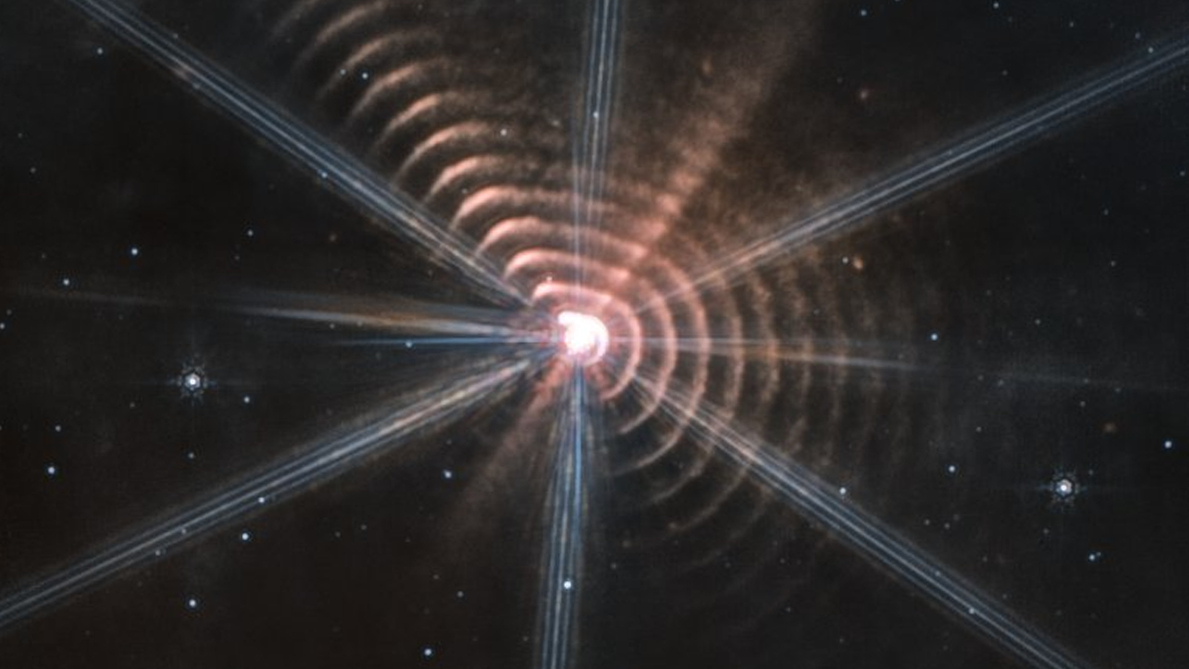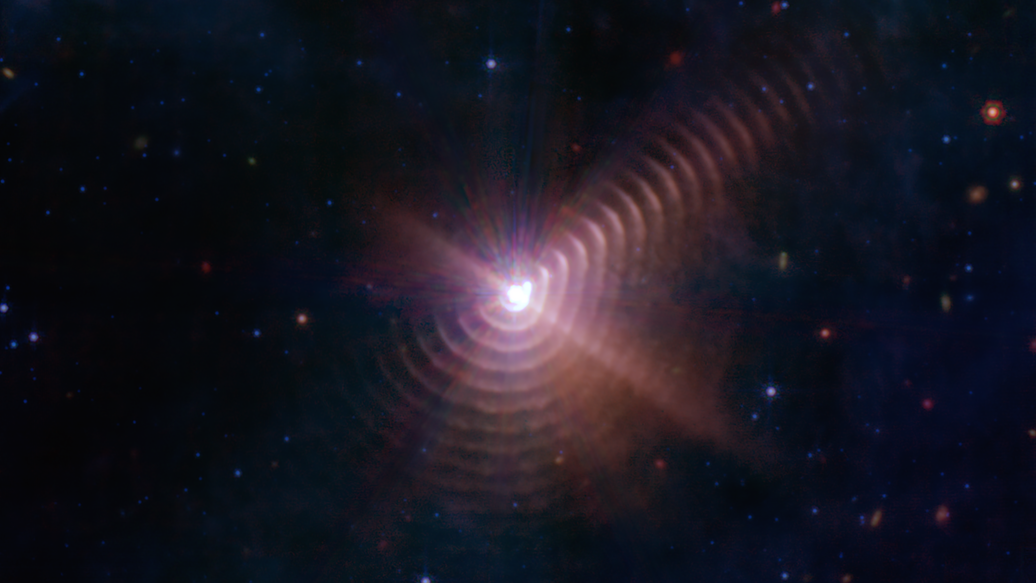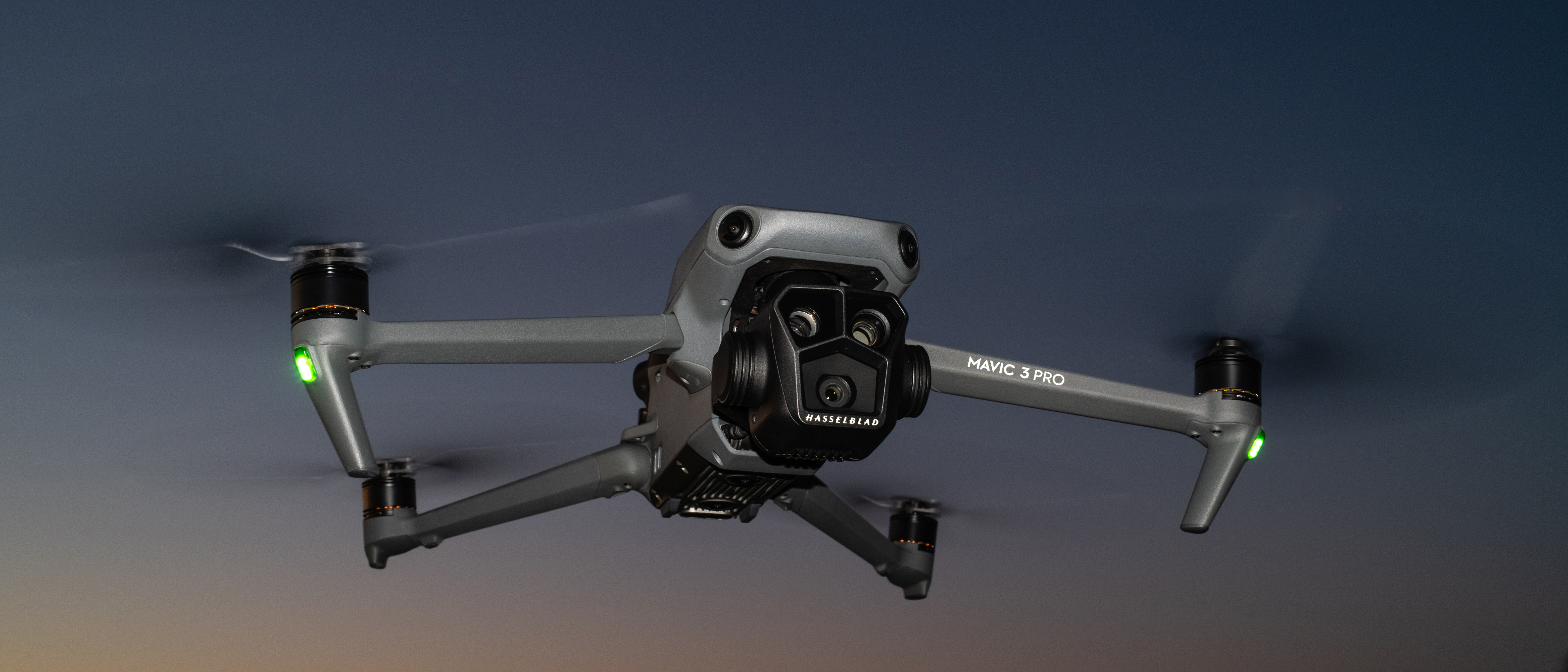Bizarre rings spied by James Webb Space Telescope are organic dust propelled by starlight
A stunning image from the James Webb Space Telescope revealing concentric angular rings around a giant, distant star stirred a frenzy online in September. "It must be aliens," some geeks speculated. (It wasn't, of course.) Now, a pair of new studies has revealed that these cosmic ripples are puffs of organic dust that was generated and then spread across the universe by an odd star system. The research is the first to have found evidence of starlight moving visible matter beyond our solar system.
The star responsible for the mind-boggling spectacle is called WR140, and is, in fact, a system of two stars that orbit each other. The WR marks one star in the pair as a Wolf-Rayet, a rare type of star that is hundreds of thousands of times brighter and much hotter than Earth's sun. Wolf-Rayet stars represent the final stage in the evolution of giant stars, dozens of times more massive than the sun, before they explode in supernovas and turn into black holes, Yinuo Han, an astronomer at Cambridge University in the U.K. and lead author on one of the new studies about WR140, told Space.com.
The other star in the WR140 system is a somewhat less bright giant star just shy of Wolf Rayet size, at about 20 times the size of the sun. The interaction of these two enormous stars triggers cosmic fireworks that give rise to the oddly shaped concentric rings that the James Webb Space Telescope photographed.
Related: How to use the James Webb Space Telescope to hunt for life around white dwarfs

"These two stars orbit each other in very elliptical orbits," Yinuo said. "Every eight years they get close to each other and produce dust." It is this dust that we see ripple away from the star in the image; the time when the stars are more distant creates the space between the rings.
It's quite usual for astronomers to witness stars producing dust, Yinuo added. But even more interesting is how this dust spreads into the surrounding universe.
"These stars form very powerful solar winds," Yinuo said, referencing streams of charged particles escaping from the atmospheres of stars including our sun. "In the case of these stars, the solar winds are more like a hurricane. When the stars get to a certain distance from each other, the hurricanes combine, and we see these fireworks, these puffs of dust."
Breaking space news, the latest updates on rocket launches, skywatching events and more!
The astronomers expected those circular puffs of dust to drift away from the star pair at a uniform speed. In the vacuum of space, there is nothing to slow the dust down, and so the shells should continue to ripple away into the surrounding galaxy at the speed of those hurricane-force winds that gave them the first kick.
However, when the researchers looked at observations of WR140 made over the past 16 years by the Keck Observatory in Hawaii, one of the largest telescopes on Earth, they found that the dust was actually picking up speed as it traveled.
"We have always known that the [dust shells] expand quickly, but we didn't know that the expansion gets quicker and quicker," Yinuo said.
The researchers believe that the dust gets the additional push from the immensely bright starlight produced by the WR140 binary star, which is about a million times brighter than the sun.
"These stars give out a very strong light," Yinuo said. "And photons carry momentum, which can interact with matter, so the light is pushing on the dust and makes it accelerate."
The principle is the same as that of solar sail propulsion, which spacecraft like the LightSail 2 mission that launched in 2019 have used to orbit Earth. However, astronomers have never observed light pushing matter in another star system until now.

The Keck Observatory repeatedly photographed a small section of WR140's innermost dust shell. The difference between the subsequent sets of images revealed the acceleration.
Keck, however, although one of the most powerful telescopes on our planet, can only see the first two of the concentric ripples. In contrast, the images from the James Webb Space Telescope reveal 17 shells spreading into the distance at perfectly spaced intervals, a testament to the telescope's observing superpowers.
"We're looking at over a century of dust production from this system," Ryan Lau, an astronomer at National Science Foundation's NOIRLab and lead author of the second paper, said in a NASA statement highlighting the new photograph. "The image also illustrates just how sensitive this telescope is. Before, we were only able to see two dust rings, using ground-based telescopes. Now we see at least 17 of them."
The James Webb Space Telescope's measurement also revealed that the dust these stars produce contains organic, carbon-rich grains, the same type of particles that are the building blocks of life on Earth. For Webb, this is just the beginning. The astronomers expect more ground-breaking discoveries about WR140 in the months and years to come.
The research is described in a paper published Wednesday (Oct. 12) in the journal Nature; a second paper on the same object also published today in Nature Astronomy.
Follow Tereza Pultarova on Twitter @TerezaPultarova. Follow us on Twitter @Spacedotcom and on Facebook.
Join our Space Forums to keep talking space on the latest missions, night sky and more! And if you have a news tip, correction or comment, let us know at: community@space.com.

Tereza is a London-based science and technology journalist, aspiring fiction writer and amateur gymnast. Originally from Prague, the Czech Republic, she spent the first seven years of her career working as a reporter, script-writer and presenter for various TV programmes of the Czech Public Service Television. She later took a career break to pursue further education and added a Master's in Science from the International Space University, France, to her Bachelor's in Journalism and Master's in Cultural Anthropology from Prague's Charles University. She worked as a reporter at the Engineering and Technology magazine, freelanced for a range of publications including Live Science, Space.com, Professional Engineering, Via Satellite and Space News and served as a maternity cover science editor at the European Space Agency.
